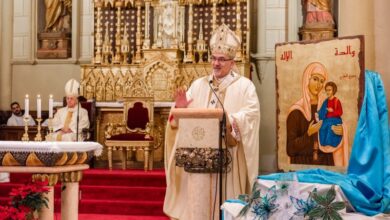Survivor of human trafficking St. Josephine Bakhita discovered God’s infinite love
ACI Prensa Staff, Feb 8, 2024 / 11:15 am (CNA).
On Feb. 8, we celebrate the feast of St. Josephine Bakhita, an African nun who was born in Darfur, Sudan, and eventually became an Italian citizen.
Josephine experienced firsthand the horrors of slavery for much of her life. The name “Bakhita” — which means “lucky” in Arabic — was given to her by those who trafficked her when she was between 7 and 9 years old. She then received the name Josefina, “Giuseppina,” 12 years later, when she was baptized.
“If I were to meet again those slave traders who kidnapped and tortured me, I would kneel down to kiss their hands because, if this had not happened, I would not now be Christian and religious,” Bakhita said in her biography. These words are an introduction to the beauty of her spirit and the greatness of her heart. Bakhita is an icon of the history of Christianity in Africa.
The future saint’s origins are not entirely clear, but she was probably born in Olgossa, a village in Darfur, Sudan, around 1869. She did not know for sure where and when she was born, nor did she remember the name she was given at birth. But she did have memories of the period before she was kidnapped and sold into slavery. “I lived a very happy and carefree life, without knowing what suffering was,” she said.
Bakhita lived with her parents and siblings until the day she was kidnapped in the forest by Arab slave traders. They took her to a town called El-Obeid, where she was sold. The man who bought her that day would be the first of a total of five “masters” who owned her during her life.
One of those five men — her fourth “master” — was particularly cruel. She suffered the worst humiliation and mistreatment by him when she was only about 13. He had her tattooed, which involved suffering 114 incisions made in her skin. To avoid later infection, these cuts were “cured” with salt over the course of a month. Reflecting on the great trauma and abuse she endured, Bakhita remarked: “I felt like I was going to die at any moment, especially when they put the salt on me.”
In 1884, Bakhita arrived in Italy accompanying her fifth “master” and a friend of his, Augusto Michieli. Michieli would become her sixth and last owner, after taking her to his house as a servant, since slavery was forbidden in Italy. She worked as a nanny in the Michieli household and became close friends with one of the family’s daughters, Minnina. Years later, both would become nuns in Venice.
It was during her time with the Michieli family that Bakhita came to know God and learned that “he had always remained in her heart,” even in the moments of greatest pain, and that he had given her the strength to be able to endure so much mistreatment.
On Jan. 9, 1890, the saint received baptism, first Communion, and confirmation. From that moment on, she took the Christian name of “Josephine Margaret Fortunate.” She decided to stay in Italy, where she felt safer, far from the danger of being enslaved again, and where she had met the one she had been waiting for all her life — Jesus of Nazareth. Together with Minnina, she entered the novitiate of the Institute of the Sisters of Charity in Venice and would become, years later, a member of the order at the age of 38 on Dec. 7, 1893.
In 1902 she was sent to Venice, where she worked cleaning, cooking, and caring for the poor. Without doing anything “extraordinary,” Bakhita earned the reputation of a saint. Always modest and humble, she maintained a firm faith, making her daily life a beautiful offering to God.
She died on Feb. 8, 1947, in Schio, northern Italy, and thousands of people came to her funeral.
Because of her spirituality, closeness to God, and strength in the face of adversity, St. John Paul II called her a “universal sister” in his homily during her beatification on May 17, 1992, saying: “In our time, in which the unbridled race for power, money, and enjoyment causes so much distrust, violence, and loneliness, the Lord gives us back Sister Bakhita as a universal sister so that she may reveal to us the secret of the truest happiness: the Beatitudes.”
John Paul II also canonized her in 2000, during the Jubilee of the second millennium, honoring the African people and all those who have suffered slavery throughout history.
In 2007, Pope Benedict XVI used the example of St. Josephine Bakhita in his encyclical Spe Salvi (“In Hope We Were Saved”) to recall what the meaning of hope is:
“Bakhita … had known only owners who despised and mistreated her or, at best, considered her a useful slave. Now, on the contrary, she heard that there was a ‘Paron’ above all masters, the Lord of all lords, and that this Lord is good, goodness in person. She learned that this Lord also knew her, that he had created her too; moreover, that he loved her. She too was loved, and precisely by the supreme ‘Paron,’ before whom all others are but miserable servants. She was known and loved, and she was expected.”
“Even more,” the pope continued, “this Owner had personally faced the fate of being mistreated and now awaited her ‘at the right hand of God the Father.’ At this moment she had ‘hope’; not only the small hope of finding less cruel owners, but the great hope: I am definitely loved, whatever happens; this great Love awaits me. This is why my life is beautiful.”
Benedict XVI further stressed that “through the knowledge of this hope she was ‘redeemed,’ she no longer felt she was a slave, but a free daughter of God. She understood what Paul meant when he reminded the Ephesians that before they were in the world without hope and without God; without hope because they were without God.”
This article was originally published by ACI Prensa, CNA’s Spanish-language news partner, and has been translated and adapted by CNA.




